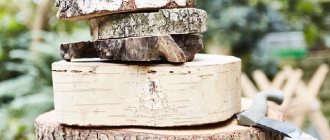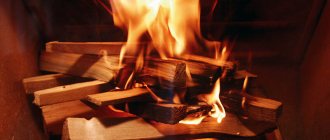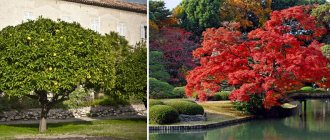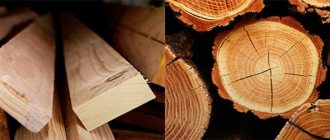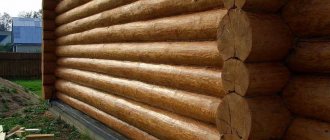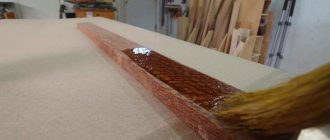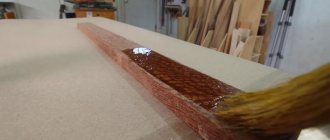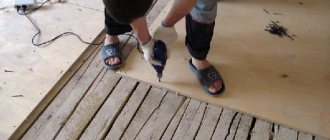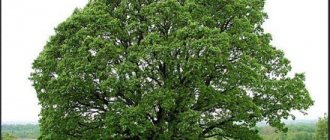Choosing wood for carpentry work
Hobbies are different. One needs to listen to music, the other needs to walk with a plane through wood that smells of forest and resin. And sitting, say, on garden furniture made by yourself is a pleasure. But any business begins with the choice of material. So, let's get to work!
What kind of wood is needed and what is it for?
Let's start with the fact that carpentry work is divided into white wood and cabinetry. The starting material for white-wood work is coniferous and soft deciduous wood. These are birch and linden, and also poplar. For cabinetry work, hard wood is used, mainly valuable hardwood. But in any case, preference is given to those tree species that have a straight trunk and a limited number of knots. Knowing the properties of wood species, you can choose the right wood for certain jobs.
For example, coniferous trees are used as a basis for veneering various parts. Due to its softness, front parts are rarely made from wood of these species. But with certain technologies, even furniture is made from coniferous wood. One of the advantages of softwood is that it is easy to stain. On the other hand, the color background muffles the decorative advantages of this wood.
Hardwood is usually used in its entirety. This category includes: birch, walnut, ash, etc. In mosaic work, veneers of both hardwood and softwood are acceptable. Wood carving is a completely different matter . Not many tree species are suitable for this purpose; for example, linden, rowan and birch are suitable. This list can be supplemented with willow and aspen. In the case when it is necessary to preserve the natural color of the tree, maple and chestnut are used, as well as pear and oak.
We choose wisely
When choosing wood, an experienced carpenter will pay attention to radial cracks in the end. In benign material they are absent altogether, and if present, they are small. And wood with cracks running through the layers is considered not at all suitable for carpentry work.
The denser the annual layers, the higher the quality of coniferous wood. Wide-grain wood is usually too loose, and therefore fragile. As for the age of trees, medium, that is, mature, is considered optimal. For example, pine is most suitable for carpentry when it reaches 80–90 years; for oak it is 80–150 years. At the same age, the tree reaches its greatest flexibility.
By the way, it also depends on what time of year the tree was cut down. Wood harvested in autumn is more flexible than wood harvested in winter. The most flexible are alder, fir, hornbeam and larch.
It would be a shame if a product made of wood splits. To prevent this, be careful when choosing wood. More surprises can be expected from dense and flexible rocks. However, the confusion of tree species reduces this likelihood.
As for the health of wood, craftsmen in every possible way avoid wood that is affected by fungal diseases. A clear sign is uneven or overly bright color. And too many knots reduce its strength.
Dry your wood correctly
Proper drying of wood in carpentry, if not paramount, is at least very important. Firstly, you should correctly determine the time required for this. Experienced carpenters know: both under-dried and over-dried wood is not suitable for work. Everything affects: humidity, temperature changes. The result, although predictable, may not be very pleasant - cracked, and therefore ruined, material.
Therefore, when drying, you need to take into account some nuances. Let’s assume that the moisture content of wood harvested in winter is lower. The reason is simple: at this time the trees slow down their growth.
There is also such a feature: hard rocks are more sensitive to both under-drying and over-drying. For soft and friable rocks, this factor is less important. If you are making a product from several types of wood, select them so that the product is homogeneous. Only in this case will the degree of drying coincide, which is important.
Similar articles:
- Carving material
- Mosaic material
- Valuable wood species - a little about valuable wood species
- Transparent finish
- Parquet - what is behind this word?
- Bleaching and degumming
Choosing wood - basic tips for beginners from Sawmill
So, you, inspired by the works of other masters, deciding to learn a new hobby, or desperate to find a finished wooden product that satisfies all your aesthetic and practical requirements, have thought about wood carving. The layout of the future work of art has already been designed down to the smallest detail, the tools are at hand, safety precautions have been observed, and you are ready to create. Now is the time to find the right wood for your purpose. Here's a little instruction that will help you avoid some mistakes and disappointments in your creative process. First, you need to know that freshly cut wood is not suitable for creating durable products. It contains too much moisture - during the drying process its fibers will shrink and the wood may warp and deform. Therefore, you need to wait until the moisture content becomes optimal - 15% for outdoor products and 8-12% for items that will be located indoors. Wood that is too dry will absorb moisture from the environment and the fibers will swell, leading to cracking. If you don’t have a moisture meter at hand, you can contact us - our wood always has the correct moisture content. The second thing you need to pay attention to is wood defects. In the first photo you can see cracks on the amaranth block and a knot on the maple block
Of course, for some, a knot or curl is an unacceptable defect that makes the piece of wood unsuitable for processing, and for others, even cracks, eyes and wormholes are a field for creative experiments, so it all depends on your idea, experience and capabilities. For example, twisted wood is difficult to process, but it makes the strongest axes. Burls and suvels, which, from the point of view of nature, are a tree’s reaction to irritants and diseases, from the point of view of many craftsmen, are picturesque and very valuable material for creativity. In the photo you can see the knotty texture of the maple burl
And we come to choosing the type of wood. Here, in order not to get lost in the diversity that nature gives us, you need to pay attention to the following: The workpiece must be suitable in density and hardness for your product. If you plan to carve small parts, then hard, dense wood will help prevent chipping. For example, hornbeam, boxwood, dogwood, and white acacia are perfect for this - these species are among the densest and hardest. Among the exotic ones, these are, of course, ebony, jacaranda, amaranth, jatoba, olive, rosewood and others. They will best withstand thin parts and small work, but be aware that most hard rocks will quickly dull the tool.
In addition, density and hardness are important for products subject to physical stress because they directly affect strength. For example, durable wood is simply needed for the handles of knives and tools, axes, and the wooden legs of pirates 
In the photo from left to right: hornbeam, santos rosewood, boxwood, dogwood, amaranth
Ring-vascular hardwoods (chestnut, ash, elm, oak: photo below) have heterogeneous density: the later the wood, the denser it is.
Conifers (for example, cedar) have low density, they are soft and can be easily processed by hand, but the tool must be kept sharp. In addition to conifers, softwoods also include some deciduous trees - linden, alder and others. This tree is perfect for beginners in carving (linden, alder and cedar in the photo)
The second thing you need to pay attention to when choosing a species for your work is the texture of the wood. The texture depends on the arrangement of the fibers and the direction of the cut, the width of the growth rings, medullary rays and large vessels. The more intricate the texture, the more often it is harder to process the wood by hand - not all craftsmen can handle different densities and directions of fibers the first time. You also need to pay attention to the fact that wood contains essential oils and tannins. Some breeds can cause an allergic reaction not only during processing, but also during subsequent use. For example, many exotics: padauk, iroko, rosewood. Allergic reactions are individual and, unfortunately, sometimes unpredictable.
In the photo there are blocks that may make your eyes water - paduk and iroko. Remember that even when working with “safe” breeds, you must use respiratory protection!
Pay attention also to the method of cutting the bars. We talk about this in more detail here.
Otherwise, when choosing wood for creativity, you can rely on your aesthetic taste, since the natural diversity of species provides a huge choice. And we are happy to try to bring it to you!
JOINERY MATERIAL. Tree species
Carpentry is unthinkable without the ability to distinguish wood species and recognize them in a workpiece or product. They learn this by preparing carpentry material directly from cut trees, the names of which are well known. You can also study texture on pieces of furniture and other products whose wood species is also known. It should be taken into account that the unfinished surface of wood differs from the finished/varnished or polished one: it is lighter and duller, and its texture pattern is much less visible.First, they learn to distinguish: spruce from pine, pine from larch, aspen and linden from birch, oak from ash. Having firmly learned to identify these rocks, studying the rest will not be difficult, as landmarks will appear.
For white-wood work, coniferous species are usually used - pine, spruce and deciduous - birch, linden, poplar. This requires relative straightness and a small number of healthy (ingrown) knots. Coniferous species are also used as a base when gluing parts with plywood made from valuable wood species.
In solid wood products, hardwood is used for a clear finish. When carving wood, which will then be painted dark, hardwoods are used - linden, birch, rowan, and willow. If the carved parts have a natural color, it is best to choose pear, maple, walnut, and chestnut.
Soft conifers are unfairly rarely used for facial details. This is usually due to the fact that the light color, simple delicate texture and softness of the wood require very sharp tools, impeccable cleanliness of work and accuracy both in assembly and finishing. Soft wood is easily damaged by an accidental careless blow. But experience shows that where these conditions are met, the joinery looks great and is in no way inferior to its counterparts made from expensive hardwood. For small products of small size (shelves, frames, drawers, etc.) you need straight-grained or, as they say, knot-free wood with clearly defined annual layers - red or marsh fine-grained pine, larch, juniper, cypress, cedar. Spruce, white pine, and fir are less expressive and require tinting and ornamental decoration with darker color layouts. Very knotty wood with large ingrown knots can also be used for panels: cleanly processed, it is very decorative.
Coniferous wood is easy to paint. To preserve the decorative advantages of coniferous wood, the coloring should be weak and give the impression of a tint. When painted in deep dark tones, coniferous wood loses its decorative qualities and looks like a cheap fake of hard wood.
Pine (pine pine) has red colored wood in very healthy and thick logs. It has orange-red veins and white-yellow spring layers. In trees affected by redness (defect), both the veins and spaces are pink. In the presence of a false nucleus, the transition region is of interest. When using wood with such a transition, you can get very decorative flat panels from boards with a mirror-like texture pattern. Boards and thick slabs of red pine are most often found in sleeper trim. Small boards from short, straight-layered logs can be obtained by splitting, from long ones - only by sawing.
Spruce has white wood with barely noticeable annual layers. It has black, chaotically scattered knots, unlike pine, in which the knots are located in whorls (groups at the same level). For the front surfaces of joinery, spruce of the resonant type (without knots) of radial cut with more pronounced layers is suitable.
Larch has a beautiful creamy-brown color, is heavy and resinous, is difficult to work with and makes the sole of the tool greasy. When drying quickly, internal cracks are common. Nitrocellulose varnishes are used for finishing; alcohol varnishes are not suitable.
Juniper is a coniferous shrub with trunks up to 10 cm thick and has a very beautiful texture. Its strong, thin-grained wood is well processed and polished. Dried old junipers can serve as excellent ornamental material. Due to the small diameter of the trunks, the shields have to be glued together from small blocks. The end cuts of juniper, suitable for inlay, are amazingly beautiful. The pleasant smell of wood lasts for a very long time, and joinery made from juniper can be compared with products made from camphor laurel, so beloved in Europe in the last century.
Cypress, thuja. The wood is similar in properties to juniper wood, but grayer and wider-grained. Cypress does not crack or warp, which is why it was previously used for icon boards. Cypress is dried in the bark in the air under a canopy for 3-5 years.
Cypress, thuja and juniper lend themselves well to fine carving. Other conifers are less suitable for small carvings, since straight-grained wood has a tendency to chip. Due to the clear large pattern of annual layers, small shaped glazing beads (layouts) made of coniferous species are inexpressive.
Hardwoods are of greatest importance in carpentry, and of these, oak should be given primacy in our territory.
Oak. When cut tangentially, wood has clearly visible pores, and when cut radially, it has core rays, is very durable, and easily stains black. Real bog oak, lying in water, has a color from brown-green to black. It is less durable than felled oak, fragile, difficult to process and dulls the incisors. In the butt part of large trees, twisting occurs. In combination with a radial cut, the texture of such an oak board is very beautiful. When chiselled, oak is fragile and requires a hard and sharp tool and great care when working. Withstands large threads well. Small oak profiles are inexpressive. The end of an oak board is darker than the face; this must be taken into account when choosing the type of joint facing the face.
Natural drying of oak in bark for 8-10 years. Before drying, the ends should be greased with petrolatum, PVA glue or sealed with paper,
Ash. Its wood is similar to oak wood, but somewhat lighter, with no core rays. When stained and dyed, it acquires an unpleasant gray color, so it is usually used in its natural color. Steamed ash bends well. Its wood is strong, knitted, and difficult to process by hand. When dried, ash cracks little.
Beech. Wood in its pure form is inexpressive. In a radial section, shiny plates appear, visible from the end as dark lines. This type of cutting gives the wood the most decorative qualities. But in terms of strength, beech has almost no equal. Screws screwed into beech tend to break, but do not tear out the wood. Chip, planed and then glued beech blocks are used for the base of carpentry tool blocks. Beech is suitable for making profile layouts and lends itself well to imitation with dark staining. Dries quickly and does not crack. Beech easily absorbs atmospheric moisture, so products made from it must be varnished. Sometimes growths called burls form on beech trunks.
Elm. The wood has a dark core and clearly visible annual layers. In a radial section, they form an interesting pockmarked appearance. By the nature of processing, hardness and other properties, elm is close to oak. The wood texture is especially beautiful in the butt part.
Elm is a southern tree with brown wood. Burls often form on elm trunks. The sawn boards made from them are exceptionally beautiful.
Sycamore, plane tree (eastern plane tree). They grow in the south of the country, the wood has a brown-brown core. The oblique direction of the wavy lines in the annual rings gives the texture of the plane tree, especially in a radial section, a grain-like appearance.
Chestnut is edible. The wood has a gray-brown core, similar to oak, but in a radial section it does not have shiny pith rays. The softness and uniform density of the wood allows it to be cut and processed in all directions.
Horse chestnut. The wood is usually cross-laminated, uniformly colored, grayish in color (resembling pine), and suitable for carvings and stains. Strength is high.
Amur velvet (Amur cork tree). The wood is similar to ash wood, but darker.
Russian maple, sycamore, black maple have dense gray-pink wood with a delicate pattern. The radial cut is especially beautiful. Maple is easily polished and accepts mordants; it can imitate most rare wood species with an even structure. In the central part of the country, obtaining maple wood is a matter of chance; in the western and southern parts, maple is found in firewood when clearing up stands during road reconstruction. Maple wood has an evenly dense structure and therefore cuts well. Products with fine profiles, carvings, and inlays are made from maple. Some varieties of maple (sugar maple, for example) have wood with a characteristic curl of grain ("bird's eye"), which is usually used as plywood for cladding. Due to the density of the wood, maple is used for the soles of planing tools for finishing work - jointers, double planes, sanders. Maple is dried in its bark whole or sawn into boards 5-6 cm thick for at least a year.
American maple, or ash-leaved maple. The texture of the wood is similar to ash wood, but is denser and has smaller pores. It is difficult to process and polish. Also suitable for making carpentry tools.
Walnut and Manchurian. The wood is red-brown in color, sometimes with dark veins. It is difficult to plan, but lends itself well to polishing and painting. Walnut burls have a particularly beautiful pattern. The burls are cut into planks, which are assembled into shields on a pine base.
Hornbeam has a hard wood of white-yellow color, very heavy, suitable for imitation of ebony. Mainly used on the soles of carpentry tools. Works well, polishes poorly.
The pear has wood of a beautiful pink color with delicate lines of annual layers. The wood is dense, heavy, and can be easily polished and painted. Suitable for small-profile carved products, drawing tools. Little warping and cracking when drying. Thanks to the developed central trunk, the pear produces long, straight pieces.
White acacia has a wide black-gray or green-brown core. Wood with tangled fibers is very strong, difficult to process when dry, and prone to brittleness when wet. But the work is rewarded by the beautiful appearance of the product. The wood is well polished. The sizes of the boards are small. Acacia is used for instrument handles, inserts, and inlays.
Mulberry (mulberry tree). The wood is red-brown in color (the sapwood is narrow) and darkens when exposed to light. It is difficult to process, dulls the tool quickly, and polishes well.
Fruit trees. Cherry, cherry, plum, apple, and apricot wood is an excellent ornamental material for a wide variety of products. As a rule, it is a very hard, finely grained wood of various shades - from white-pink to black-blue and purple in the core parts. With the exception of cherries, pieces of wood from these species are not long due to the branching structure of the trees. Plum is hygroscopic and requires varnish protection of the surface or boiling in lime water to prevent cracking. The wood of fruit trees is well polished and accepts various mordants and stains. Its acquisition is random.
Birch is the most common hardwood species. The wood is white, suitable for a variety of colors, easy to work with, but fragile when worked with a chisel. The lower part of the trees often exhibits twisting and waviness. Sometimes the inside of the trunk is black or red-brown in color with high decorative qualities.
Often, growths called burls form on birch trunks. You don't have to cut down the tree to cut the burl. If you take a transverse, sharply sharpened narrow (10-12 mm) beam blade with a large (more than two thicknesses) spread and rivet wire handles to it, then, working together, it is not difficult to cut off the growth from the trunk with such a saw. Before cutting, it doesn’t hurt to make sure that the growth is massive: it is often filled with a mass of under-bark.
It is better to cut burls and prepare birch trunks in the fall. The trunks are sawn lengthwise in the middle, or into boards. You cannot dry it in the bark. The burl is dried in bark: coated with a mixture of clay and cow dung and buried in dry sand for 2-3 months. Birch boards warp greatly when dried, so it is advisable to dry them under a load or in a bundle. Well-seasoned boards and beams can be found in construction waste, where birch is used as an auxiliary material for formwork and scaffolding.
In modern carpentry, birch is given unjustifiably little attention, but the history of Russian carpentry indicates that it was one of the favorite materials. Its ability to polish and paint, its flexibility with tools and bending (in a steamed state) is beyond praise! Therefore, we can strongly recommend birch for the most delicate and important work.
It should be taken into account that a product made of solid wood is more valuable than a product covered with plywood, even expensive types of wood.
Karelian birch is practically inaccessible to the amateur, since all trees are registered and plywood can only be obtained by chance.
Alder (black) in wetlands reaches 15 m in height and 50 cm in diameter, which makes it possible to obtain large boards. When exposed to air, wood quickly darkens. It is easy to process and imitates mahogany especially well. It is better to prepare small black alder boards by splitting round timber along radii.
Linden, aspen, poplar, and silver poplar have soft white wood that does not crack when dry, dries out little, and is easy to cut. The exception is dry aspen, which is difficult to process. In the wood of silver poplar there are areas pierced with dots and curls, which may be of interest for decorative finishing of products,
Rowan... The wood is white, durable, and has the ability to glide well, making it suitable for the soles of planes. The wood should be dried thoroughly, as it warps greatly.
The mentioned soft rocks are suitable for carving and making profile parts, provided they are painted in dark colors. In combination with hard rock, they can be used in finishing.
Shrubs are also suitable for carpentry.
Lilac has hard wood. When treated with a weak solution of hydrochloric acid, it takes on a purple color and is suitable for inlay.
Buckthorn and forest honeysuckle have very hard, bone-like wood that takes polish well and does not crack.
Hawthorn has hard wood with a beautiful yellow-brown color. Old hawthorn trunks can be up to 15 cm thick.
Array
Solid wood itself is obtained from a tree cut down and cleared of branches and bark. The value of a particular wood depends on the type of tree and the structure of its trunk. Solid wood is used in carpentry in the form of boards of different lengths, beams, beams, beams, and various kinds of figured elements.You should first consider the structure of wood itself in Figure 1.
1. Main cuts of the trunk.
Here the main technological cuts are: - transverse (in Fig. 1 this is plane B), - radial (plane B), - tangential (plane A is a section tangential to the growth rings).
The most visual representation of the structural texture of wood is provided by a tangential cut. In the central part of the tree trunk there is a core 1 (the core is usually the loosest tissue).
2. Tree rings.
Tree rings radiate from the core in concentric circles around the circumference, forming sapwood; each ring represents annual growth, which allows us to determine the age of the trunk.
Rice. 1
A - tangential cut; B - radial section; B - cross section
1 - core; 2 - core; 3 - sapwood; 4 - bark; 5 - medullary rays; b - annual rays
3. Tree species.
Wood species are divided into those with a core and those without a core. They are also called core and coreless.
Coreless species have only core 1 and sapwood 3. The quality of sapwood is significantly inferior to the core, and therefore, for example, oak wood itself varies in quality. The oak core is valuable (for cabinetry), and the sapwood of this valuable species is not used at all in carpentry.
Carpentry is unthinkable without the ability to distinguish wood species from one another and recognize them in a workpiece or product. For white-wood work, coniferous species are usually used - pine, spruce and deciduous - birch, linden, poplar. Coniferous species are also used as a base when gluing parts with plywood made from valuable wood species. Solid wood products use hardwood for a clear finish. When carving wood, which will then be painted dark, hardwoods are used - aspen, linden, birch, rowan, and willow. If the carved parts have a natural color, it is best to choose pear, maple, walnut, and chestnut.
Brief characteristics of the main tree species and their application
Hardwood.
Hardwoods are of the greatest importance in carpentry, of which oak should be given primacy in our territory.
Oak (hardwood) - used in furniture production, construction (milled wooden parts, parquet), carriage building, shipbuilding, hydraulic engineering, oak wood is durable, strong, hard, resistant to rotting, has a beautiful texture, and bends well. Oak has clearly visible pores when cut tangentially, and core rays when cut radially; very durable, easily stained black. Real bog oak that has lain in water has a color ranging from brown-green to black. In combination with a radial cut, the texture of such an oak board is very beautiful.
Beech (hardwood) - used in furniture production (parquet, veneer, carpentry tools, containers), in shoe production (lasts), and mechanical engineering. Acetic acid and creosote are obtained from beech wood by dry distillation. Beech wood is strong, but susceptible to rotting, it is well processed, impregnated, and bends well. It warps a lot when it dries out.
Beech in its pure form is not expressive. In a radial section of the beech, shiny plates appear, visible from the end as dark lines. This type of cutting gives beech wood the most decorative qualities. But in terms of strength, beech has almost no equal.
Elm has a dark core and clearly visible annual layers. In a radial section, they form an interesting pockmarked appearance. By the nature of processing, hardness and other properties, elm is close to oak. The wood texture is especially beautiful in the butt part.
Hornbeam (hardwood) - used in turning, mechanical engineering, and textile production. The bodies of carpentry tools are made from hornbeam. Hornbeam wood is distinguished by its hardness, heaviness, difficult to process, and very resistant to abrasion. Like beech, hornbeam wood warps greatly when it dries out.
Ash (a durable and tough wood) is widely used in the manufacture of sports equipment, in furniture production, in aircraft manufacturing, in carriage building, shipbuilding, and in housing construction.
Ash resembles oak wood, it is somewhat lighter, and has no core rays. When stained and dyed, it acquires an unpleasant gray color, so it is usually used in its natural color.
Carpentry tools are made from ash. The wood is strong and tough, has a beautiful texture, durable, and resistant to decay. Ash wood bends well, warps a little, but is poorly saturated with antiseptics. Elm, elm, elm (dense, durable species) - these species, due to their beautiful texture, are widely used in furniture and plywood production. Having great strength, they are used in mechanical engineering and carriage building. The wood of elm, elm, and elm is distinguished by its strength, viscosity, and density. It resists wear well and bends well.
Walnut (hardwood) - scope of use - furniture and plywood production, housing construction (interior wood finishing). Walnut wood is heavy, durable and hard with a beautiful texture. The wood is well processed and polished well. Linden (soft wood) - pencils, toys, musical instruments, and other products are made from it. Linden is also widely used in furniture and plywood production. Linden wood is soft, light, and easy to process. When drying, linden shrinks significantly, but warps and cracks to an insignificant extent.
Walnut and Manchurian walnut have red-brown wood, sometimes with dark veins, are difficult to plan, and lend themselves well to polishing and painting. Walnut burls have a particularly beautiful pattern; Burls are cut into planks, which are assembled into shields on a coniferous base. Hornbeam has a hard wood of white-yellow color, very heavy, suitable for imitation of ebony. Mainly used on the soles of carpentry tools. Works well, polishes poorly. The pear has wood of a beautiful pink color with delicate lines of annual layers. The wood is dense, heavy, and can be easily polished and painted. Suitable for small-profile carved items, drawing tools. Little warping and cracking when drying. Thanks to the developed central trunk, the pear produces long, straight pieces. Birch (moderately hard) - widely used in the manufacture of skis, gun stocks, parquet, laminated plastics, particle boards and fiberboards, and cellulose. Housing construction, furniture and plywood production are also areas of application for birch. Where there is high humidity, birch wood is not used. Birch is uniform in density, moderately hard, and easy to process. Birch material is often imitated to resemble valuable species, is well polished, painted, and can be impregnated well. But birch is not resistant to decay and warps, which narrows its scope of application.
Maple (hardwood) - area of application - mechanical engineering, plywood, music and furniture production. In shoemaking, lasts are made from maple, and in carpentry, lasts for planes are made. Maple wood is characterized by strength, density and hardness, and has an impressive glossy surface. Amenable to painting and polishing. The drying rate is insignificant.
Russian maple, sycamore, black maple have dense gray-pink wood with a delicate pattern. The radial cut is especially beautiful. Maple is easily polished and accepts mordants; it can imitate most rare trees with wood of an even structure. American maple, or ash-leaf, has a wood texture similar to ash, but with smaller pores and denser wood; it is difficult to process and polish.
Aspen (softwood) - this type of wood is widely used in the match industry, construction, and in the viscose industry for the production of rayon. Aspen, like poplar, is successfully used for various crafts and for making toys. Roofing tiles are also made from aspen. The wood is soft, has few knots, is light, can be processed well, is well impregnated and glued together. Of particular note is the strength of aspen in the aquatic environment and its resistance to woodworms. Aspen warps little and is resistant to cracking.
Poplar - used as a good ornamental material (dishes, troughs, spoons, toys, etc.), used in the production of pulp and in construction. Poplar wood is soft, dries out quite strongly, bends poorly, and is susceptible to rotting. The material of this breed is mossy. Alder (softwood) - the area of application of alder is quite extensive - this includes carpentry and furniture production, plywood production, and lumber production. Alder has proven itself well in underwater construction, in particular, it is used to construct log houses for wells. Alder is used in the manufacture of souvenirs; it is a good material for artistic processing (wood carving). Considering that alder does not give off any odor, it is indispensable in container production.
Elm is a southern tree with brown wood. Burls often form on elm trunks. The sawn boards made from them are exceptionally beautiful. Sycamore, plane tree (eastern plane tree), growing in the south of the country, have a brownish-brown core. The oblique direction of the wavy lines in the annual rings gives the texture of the plane tree, especially in a radial section, a grain-like appearance. Edible chestnut has a gray-brown core, the wood is similar to oak, but in a radial section it does not have shiny core rays. Horse chestnut is usually cross-laminated, the wood is evenly colored, grayish in color (reminiscent of pine), and is suitable for carvings and mordants. Strength is high. Amur velvet (Amur cork) has wood similar to ash wood, but slightly darker.
Rare hardwoods.
Rare deciduous species include pear, cherry, white acacia, and apple . The density of the wood of these species exceeds oak and beech, has a beautiful color, is well processed and polished. The wood of the listed species is mainly used in ornamental work.
White acacia has a wide black-gray or green-brown core, very durable wood with tangled fibers, difficult to process in a dry state. Wet - prone to brittleness. But the work is rewarded by the beautiful appearance of the product. Mulberry (mulberry tree) has red-brown wood (narrow sapwood); Wood darkens when exposed to light. The wood of fruit trees - cherry, cherry, plum, apple, apricot - is an excellent ornamental material for a wide variety of products. As a rule, it is a very hard, fine-grained wood of various shades - from white-pink to black-blue and purple in the core parts. With the exception of cherries, pieces of wood from these species are not long due to the branching structure of the trees. Birch is the most common hardwood and is suitable for a variety of stains.
Coniferous species.
Pine (softwood) is a good building material in various fields; it is most widely used in furniture production, including various artistic crafts. Pine wood is quite strong, light, and soft. When it dries, it warps a little, is well processed, impregnated and painted.
Spruce (softwood) - main use - pulp and paper production and construction. A good material for the furniture industry, for the manufacture of musical instruments, and is used in the manufacture of tannins. Spruce, as a material, is inferior to pine. Although spruce wood has a similar structure to pine, it is more knotty, is processed worse, and is poorly impregnated with antiseptics. However, spruce, due to its low resin content, holds glue better and dries faster. Spruce has white wood with barely noticeable annual layers. It has black, chaotically scattered knots, unlike pine, in which the knots are located in whorls (groups at the same level).
Juniper , a coniferous shrub with trunks up to 10 cm thick, has a very beautiful texture The end cuts of juniper, suitable for inlay, are amazingly beautiful. The pleasant smell of wood lasts for a very long time and carpentry made from it can be compared with similar products made from camphor laurel, so beloved in Europe in the last century.
Cypress and thuja are similar in properties to juniper, but their wood is grayer and wider-grained. Cypress does not crack or warp, which is why it was previously used for icon boards. Cypress, thuja and juniper lend themselves well to fine carving. Other conifers are less suitable for small carvings.
Fir (softwood) - used in the pulp and paper industry, construction, furniture industry, and in the manufacture of musical instruments. Fir is also used in medicine to make fir oil. Fir wood is close in its characteristics to spruce. Soft and light, it is difficult to impregnate with antiseptics. The scope of application of fir is narrowing due to its instability against decay.
Cedar, Siberian pine (softwood) - the area of application is the same as that of pine (construction, furniture industry, carpentry, pencil making, etc.). In terms of physical and mechanical properties, it is between spruce and fir, but is more resistant to rotting. Well processed.
Larch is a beautiful wood with a beautiful creamy brown color.
Imported wood.
Eucalyptus (hardwood) - is used in bridge construction, hydraulic structures, underwater technologies and, of course, in residential and industrial construction. Eucalyptus wood is strong, hard and heavy. Very resistant to rotting. But it is difficult to process; the core of the tree is poorly saturated with antiseptics. Grows in Georgia, Australia, Indonesia, and the Philippines.
Mahogany (mahogany). The wood of this tree is used to make high-quality furniture, panels, various crafts and accessories. Mahogany carpentry tools are highly valued. Veneer from this tree is used to decorate prestigious products. The wood is hard, durable, does not crack or warp. Very beautiful texture. Mahogany is a low-density species that can be processed well industrially, but is difficult to process manually. Grows in Mexico and Central America.
Cork (balsa) - in carpentry it is used for the inner layers of laminated laminated wood. Good heat and sound insulator, filler for life-saving equipment. Balsa wood is the lightest, fastest growing and softest of all tree species. Grows in Mexico, Central America and South America (Ecuador). There is balsa in Georgia (Colchis).

